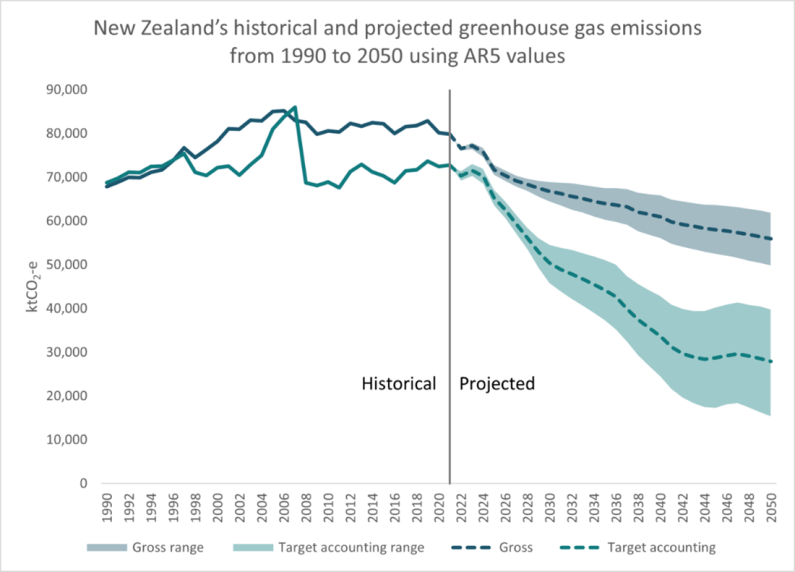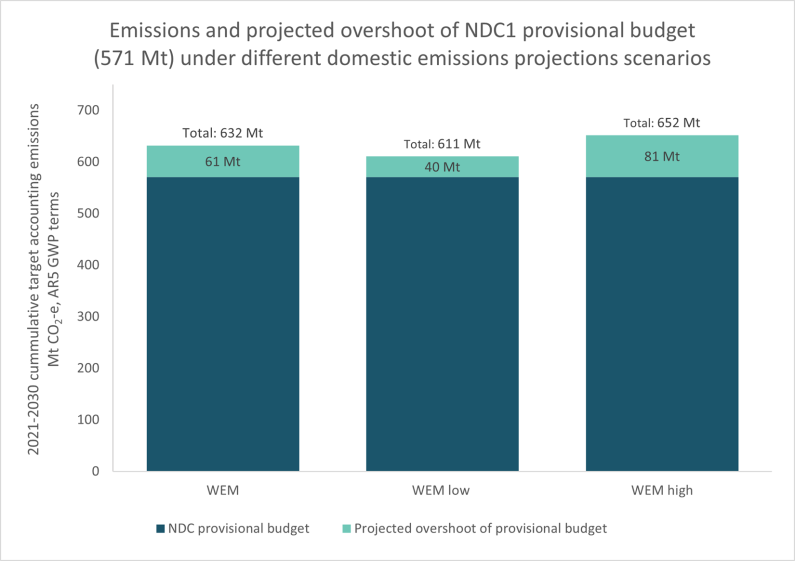New Zealand’s projected greenhouse gas emissions to 2050
These projections estimate our future greenhouse gas emissions to 2050.
These projections estimate our future greenhouse gas emissions to 2050.
Aotearoa New Zealand has both domestic and international greenhouse gas emission reduction targets up to the year 2050.
Projections are uncertain but are based on the best information we have to help us understand how we are tracking towards our targets.
The information on this page is based on the 2023 submission of New Zealand's Greenhouse Gas Inventory (1990-2021).
It is a snapshot based on policies implemented or adopted by the Government as of 1 July 2023, and economic conditions and other assumptions as of that date.

Graph data file [Excel, 428 KB]
March 2024: data has been updated to reflect the correct historical data for the energy sector, aligned with the 2023 Greenhouse Gas Inventory. This did not change the final projections.
Aotearoa New Zealand’s domestic target under the Climate Change Response Act is:
The projections to 2050 on this page include all greenhouse gases. Target accounting (net) emissions excluding biogenic methane are not shown on the graph above, but are estimated to be between -13.4 Mt CO2-e (low estimate) and 39.9 Mt CO2-e (high estimate) in 2050. However, there is a lot of uncertainty associated with this estimate.
Emissions budgets are stepping stones along the path to the 2050 target. Meeting each of our emissions budgets will make it more likely that we will ultimately achieve this target.
The first emissions budget (2022–2025) is 290 Mt CO2-e. Target accounting emissions for the first emissions budget period are projected to be 277 Mt CO2-e (low estimate 272 Mt CO2-e, high estimate 284 Mt CO2-e).
The second emissions budget (2026–2030) is 305 Mt CO2-e. Target accounting emissions in the second emissions budget period are projected to be 281 Mt CO2-e (low 267 Mt CO2-e, high 296 Mt CO2-e).
The third emissions budget (2031–2035) is 240 Mt CO2-e. Target accounting emissions in the third emissions budget are projected to be 233 Mt CO2-e (low 203 Mt CO2-e, high 264 Mt CO2-e).
Aotearoa New Zealand has an international target to reduce net emissions to 50 per cent below gross 2005 levels by 2030.
This corresponds to a provisional emissions budget of 571 Mt CO2-e over the period 2021 to 2030 (the Nationally Determined Contribution (NDC) provisional budget).

An account of progress towards meeting the NDC will be made in New Zealand’s first biennial transparency report under the Paris Agreement which will be published in 2024.
All projections are inherently uncertain and become more uncertain the further out they are made.
The underlying assumptions – such as economic and population growth, the price of emissions in New Zealand’s Emissions Trading Scheme (NZ ETS), technological advancement, or even how favourable the weather is to generating hydroelectricity – can all change. The Government may add or remove policies, and new scientific information might change our estimates of our emissions.
These projections used a rising NZ ETS price. This is unlikely to reflect actual market prices which are dynamic and changeable to reflect market conditions. This is particularly relevant for the third emissions budget period and creates additional uncertainty for this budget. The NZ ETS price assumption will be reassessed in future projections modelling.
Continuing to reduce our emissions will give us the best chance of meeting our emissions budgets and our longer-term targets, even if underlying circumstances or assumptions change.
The emissions projections to 2050 are based on New Zealand's Greenhouse Gas Inventory (1990-2021) which provides emissions data up to 2021. The projections have been prepared under the UNFCCC guidelines for reporting emissions within the National Communications and Biennial Report and are consistent with target accounting rules.
These projections use the 100-year time horizon global warming potentials (GWPs) for the non-carbon dioxide gases based on the values provided in the Intergovernmental Panel on Climate Change's Fifth Assessment Report (AR5). The use of 100-year GWPs provides a standardised measure to compare the warming impact of different greenhouse gases over a consistent timeframe, helping assess their contributions to climate change in a meaningful and comparable way.
The projections scenario presented on this webpage is the ‘with existing measures’ scenario, which includes policies implemented or adopted by the Government by 1 July 2023, along with the economic conditions and other assumptions as of that date.
Gross emissions include emissions from all sectors of the New Zealand economy excluding forestry and land-use emissions/removals. This includes energy (including transport), agriculture, industrial processes and product use and waste.
Gross and net emissions are reported annually, by sector, in New Zealand’s Greenhouse Gas Inventory, as required under the United Nations Framework Convention on Climate Change (UNFCCC).
Target accounting emissions include gross emissions, along with a subset of our forestry and land-use emissions and removals. Target accounting is designed to be compatible with our net emissions targets under which removals from pre-1990 forests are not counted.
Target accounting emissions count towards New Zealand’s Nationally Determined Contribution under the Paris Agreement (2021–2030) as well as New Zealand’s domestic targets and budgets.
Projections are calculated annually. Projections based on the 2024 submission of New Zealand’s Greenhouse Gas Inventory (1990-2022) will be released in 2024.